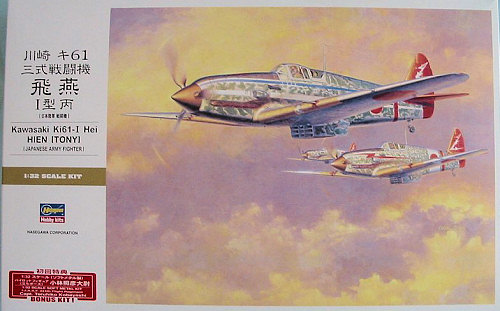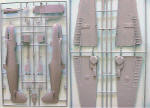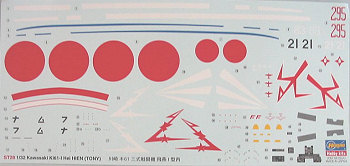
| KIT: | Hasegawa 1/32 Ki-61-Ihei "Hein" |
| KIT #: | 08078 (St 28) |
| PRICE: | 4200 yen at www.hlj.com |
| DECALS: | Four options |
| REVIEWER: | Tom Cleaver |
| NOTES: | New mold |

| HISTORY |
The Japanese Army Air Force was extremely conservative in its view of what constituted a good fighter. As a result, when the JAAF entered the Pacific War, its main fighter was the obsolete (by Western standards) Nakajima Ki.27 (Nate), and its newest fighter - which only equipped one fighter Sentai - was the already-obsolescent Ki.43 Hayabusa (Oscar). While both fighters were highly-maneuverable and could give Western opponents fits, an Allied fighter pilot had only to keep his speed up and avoid high-G "dogfight" maneuvering in the horizontal plane to neutralize the good qualities of either fighter, with the Allied pilot able to break off combat at will through use of superior speed overall, and higher diving speeds. One good hit by the heavier firepower of the western fighter was usually enough to blow either of these fighters apart, due to their light construction and lack of armor.
The first JAAF fighter that met Western standards to see combat in the Pacific War was the Kawasaki Ki.61, known officially as the Type 3 Model 1 land-based interceptor. The Japanese name was Hien - which translates as "Flying Swallow" - while the Allied code name was "Tony." First encountered over New Guinea in 1943, where it was initially thought by the Allies to be perhaps a development of either the Messerschmitt Bf-109 or the Macchi C.202 (hence the code name), the Ki.61 gave a good account of itself throughout the remainder of the Pacific War. It was considered by its opponents to be one of the most dangerous Japanese fighters, and very difficult to shoot down.
Kawasaki had acquired the manufacturing rights to the new series of Daimler-Benz aircraft engines in 1937, though it would not be until 1940 that the JAAF would take advantage of this fact. In February 1940, Kawasaki received development contracts for two fighter designs to be powered by the Daimler-Benz DB601A: the Ki.60 and Ki.61. Of the two, the Ki.60 was a very straightforward attempt to emulate European design standards, with the result being a "heavy" fighter with a top speed of 350 mph, which was the fastest of any JAAF aircraft to date when it first flew in March 1941 with a German DB601A engine. The Ki.60 was, however, ahead of its time so far as the JAAF was concerned, and further development was given over to the lighter, more "Japanese," Ki.61.
Kawasaki had simultaneously been working on the Ha.40, an indigenous development of the DB601A that was lighter than the original German engine, and rated at 1,175 h.p. Unfortunately, this lightness of design would ultimately be the downfall of the engine, because it could not stand up to prolonged operational use, in addition to being subject to poor quality control in production.
The Ha.40 powered the Ki.61 prototype which first flew in December, 1941. In early tests the aircraft achieved a top speed of 368 mph, though this would never be matched by production versions until the introduction of the higher-powered Ki.61-II in 1943. Twelve additional prototypes were built, and were flown in comparison with captured U.S. P-40Es from the Philippines and a German Bf-109E - the Ki.61 was superior to both.
The first production Ki.61 was powered by the production version of the Ha.40, the Type 2 Ha.60/22, rated at 1,100 hp and providing a top speed of 348 mph. The initial production version, the Model The Ki.61-I, was armed with two 7.62mm machine guns in the fuselage, and two 12.7mm weapons in the wings.
In August, 1943, production switched to the Model 1a, in which the 12.7mm wing guns were replaced by German 20mm MG 151 Mauser cannon. Only 800 of these weapons were obtained from Germany, limiting production of the Model 1a to 400 aircraft. An interim production version, the Model 1b, replaced the previous armament with 4 12.7mm weapons in both the fuselage and wings. In January 1944, production switched to the Model 1c, which substituted domestically-designed Ho-5 20mm cannon for the wing armament.
After fighting in New Guinea, the Ki.61 next appeared over Rabaul. This was followed by deployment to China, where it proved more than a match for the P-40s of the 23rd Fighter Group, which in turn led to expedited equipment of the 23rd FG with the P-51 Mustang in early 1944. The Ki.61 also equipped units based in the Philippines in 1944.
Allied fighter pilots respected the Ki.61, which provided better armor protection for the pilot and engine than other Japanese fighters, while providing excellent maneuverability and a diving speed that allowed it to keep up with any Allied fighter that attempted to disengage by diving.
The appearance of the B-29 in significant numbers over Japan, beginning in November 1944, led to the return of as many Ki.61-equipped units to the Home Islands as possible. In limited combat against the China-based B-29s in the summer of 1944, the Ki.61 had proven to be one of the few Japanese fighters capable of meeting the B-29 at altitudes over 30,000 feet. It equipped Japanese Taiatari (special attack) units, such as the 244th Sentai based outside Tokyo, since its design allowed for ramming attacks against B-29s that gave the pilot a good chance of a successful bailout just before impact.
Unfortunately for the Ki.61, the Ha.40 engine became an ever-increasing source of trouble, varying greatly in rated power between specific engines due to poor production quality control. The designed-in lightness of the engine led to main-bearing failures and oil system faults. By the Spring of 1944, production of the Ki.61 was lagging due to the fact that production of the Ha.40 had been cut back in an attempt to restore production quality. Production of the engine stalled out completely in the summer of 1944 due to a severe shortage of cylinder blocks and crankcases. Further development of the Ki.61 in the Ki.61-II and -III versions with a higher-powered development of the Ha.40 - the Ha.140 - were completely unsuccessful due to the failure of the engine, though when the engine worked properly the Ki.61-II was the only Japanese interceptor capable of maintaining combat formation up to 33,000 feet.
The best-known unit to operate the Ki.61-I-KAI was the aforementioned 244th Sentai. Based at Chofu, a suburb of Tokyo, their efforts were guaranteed heavy coverage in the national media. Led by Captain Teruhiko Kobayashi, the youngest Sentai commander in the J.A.A.F., the 244th became known to the 20th Air Force B-29 crews for their terrifying ramming attacks, and eventually was the top-scoring Japanese unit against the B-29s.
| THE KIT |
 To my mind, the Ki.61 Hien is the best-looking Japanese fighter of the
Pacific War, from a strictly-aesthetic point of view, with its narrow fuselage,
pointed nose, and graceful wings. Tamiya produced a 1/50 Ki.61 in the late
1960s, but this suffered major fuselage outline irregularities due to the fact
it was designed to take an electric motor inside, which additionally meant that
interior cockpit detail was non-existant. Otaki released a Ki.61 in the early
1970s in 1/48 scale, which is accurate and can still be found, though it has a
bit more recessed surface detail - in the form of rivets - than one might care
for today, as well as a cockpit in need of detailing. Hasegawa first released a
Ki.61 in 1/72 scale in 1974, which was the first accurate kit of this airplane
released by any manufacturer, with very nice (for the time) cockpit detail.
This kit is still in production nearly 35 years later, and can be safely
recommended to any modeler who builds in the smaller scale.
To my mind, the Ki.61 Hien is the best-looking Japanese fighter of the
Pacific War, from a strictly-aesthetic point of view, with its narrow fuselage,
pointed nose, and graceful wings. Tamiya produced a 1/50 Ki.61 in the late
1960s, but this suffered major fuselage outline irregularities due to the fact
it was designed to take an electric motor inside, which additionally meant that
interior cockpit detail was non-existant. Otaki released a Ki.61 in the early
1970s in 1/48 scale, which is accurate and can still be found, though it has a
bit more recessed surface detail - in the form of rivets - than one might care
for today, as well as a cockpit in need of detailing. Hasegawa first released a
Ki.61 in 1/72 scale in 1974, which was the first accurate kit of this airplane
released by any manufacturer, with very nice (for the time) cockpit detail.
This kit is still in production nearly 35 years later, and can be safely
recommended to any modeler who builds in the smaller scale.
Hasegawa first released the Ki.61 in 1/48 in 1994. There have been several limited releases of the kit with various markings in the years since. This new Ki.61-I-KAI, which was a surprise announcement at the recent Shizuoka Model Show in Tokyo last month, is the first release in 1/32 scale by a mainstream manufacturer. There is also a considerably more expensive resin kit that has been released by MDC, which suffered from complaints about quality control of the major parts by its initial buyers I am told.
This new kit is highly reminiscent of the earlier 1/48 kits. It is accurate, with thin trailing edges on all flying surfaces, and has a cockpit that is detailed sufficiently out of the box that most modelers will not feel an overpowering need for a resin replacement - though I am sure at least MDC will be offering one if only to recoup the losses on their full kit, orders for which stopped completely within days of the announcement by Hasegawa of this kit. For me, the one negative for all the earlier kits in smaller scales has been that the canopy is one-piece and cannot be displayed open without major surgery or replacement by a vacuform canopy. Fortunately, this kit provides the option of either a closed or open canopy.
Decals are the new style Hasegawa type, with white areas that really are, and
with sufficient opacity to go over surface paint without markings like blotches
showing through. The kit supplies markings for the Ki.61-I flown by Captain
Kobayashi on January 27, 1945, when he scored his second B-29 kill by ramming
his opponent. This is not the far better-known (because it was more widely
photographed) Ki.61 with blue stripe markings and 12 B-29 kills under the
cockpit that most  people
associate with Kobayashi. There is an additional 244th Sentai
rudder marking in red, which would be correct for an overall-silver airplane,
and which might be the Ki.61 flown by Kobayashi when he shot down his first B-29
in November 1944 (which might actually be the other one before it was repainted
with a red rudder and camouflaged). I am sure a sensei over at
www.j-aircraft.com will have the proper information on this. The other two
markings options are for an overall-silver Ki.61 of the 18th
Sentai flown by Lieutenant Mitsuo Koyake in January 1945 that has a very
colorful red and white sunburst on the rudder, and an overall-camouflaged Ki.61
of the 39th Chutai in March 1945. Both of these airplanes are
B-29 “killers” from the victory markings they carry.
people
associate with Kobayashi. There is an additional 244th Sentai
rudder marking in red, which would be correct for an overall-silver airplane,
and which might be the Ki.61 flown by Kobayashi when he shot down his first B-29
in November 1944 (which might actually be the other one before it was repainted
with a red rudder and camouflaged). I am sure a sensei over at
www.j-aircraft.com will have the proper information on this. The other two
markings options are for an overall-silver Ki.61 of the 18th
Sentai flown by Lieutenant Mitsuo Koyake in January 1945 that has a very
colorful red and white sunburst on the rudder, and an overall-camouflaged Ki.61
of the 39th Chutai in March 1945. Both of these airplanes are
B-29 “killers” from the victory markings they carry.
Hasegawa lists this kit as a Ki.61-I HEI, but the Ki.61s used by the 244th Sentai were KAI models with the Ho-5 cannon. I am informed by others who know more that there were differences in the length of the engine cowling between the Hei and the Kai versions, but have lost the information about which was what in the intervening years since my last review of a Ki.61 kit. As I look at this kit, it seems to me to be the shorter-nosed version, which would be the Hei. I am not aware of which version Kobayashi was flying in January 1945, but this might be the reason why the better-known airplane - which is definitely a Kai - is not done here. I do not know of any visual difference between the Ki.61 sub-type with the German cannon in the wings and the sub-type with the 4 12.7 machine-gun armament, so it should be possible to model just about any earlier Ki.61 with this kit.
| CONCLUSIONS |
Ever since Hasegawa released the Ki.84 in 1/32, modelers had expected they might release a Ki.61, inasmuch as they “own” the airplane in smaller scales. This beautiful kit completely lives up to my hopes and expectations, and to those of everyone else who has seen the kit. Examining the kit, the only aftermarket item it really needs is a set of seatbelts. Fortunately, Eduard does a very good JAAF seatbelt set (both early and late styles) in 1/32 photoetch, while Cutting Edge does 1/32 Japanese seat belts in their posable resin line. This is a kit that will look spectacular built OOB. I am sure the aftermarket decal companies will be up-sizing their previous 1/48 releases for Ki.61s very soon. At a price this low (only a few dollars more than the 1/48 kit if you pay non-Japanese prices), this is a 1/32 kit that is affordable for those who will want to do more than one. I think it is one of the best 1/32 kits released by anyone.
Review kit courtesy of HobbyLink Japan. Get yours at (real bargain) “Japanese prices” at www.hlj.com
If you would like your product reviewed fairly and quickly by a site that has over 300,000 visitors a month, please contact me or see other details in the Note to Contributors.